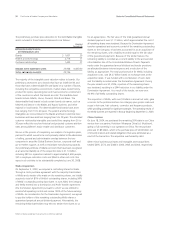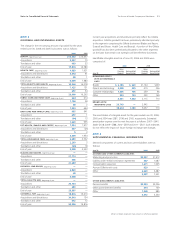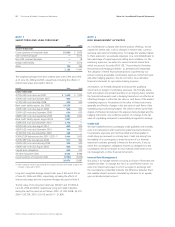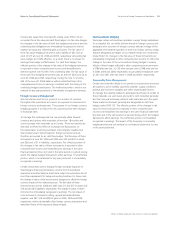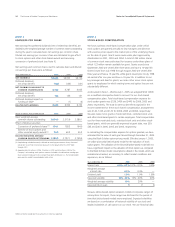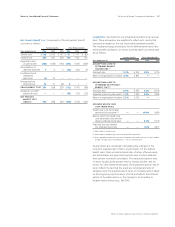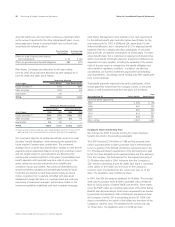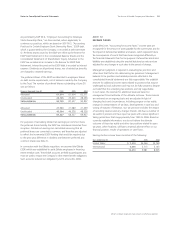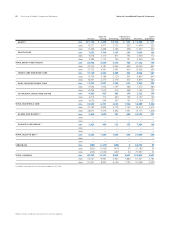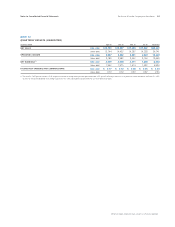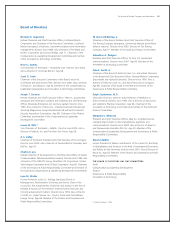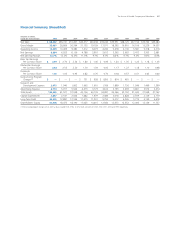Proctor and Gamble 2006 Annual Report Download - page 62
Download and view the complete annual report
Please find page 62 of the 2006 Proctor and Gamble annual report below. You can navigate through the pages in the report by either clicking on the pages listed below, or by using the keyword search tool below to find specific information within the annual report.
Millions of dollars except per share amounts or otherwise specified.
Notes to Consolidated Financial Statements
The Procter &Gamble Company and Subsidiaries
60
The income tax provision consisted of the following:
Years ended June 30 2006 2005 2004
CURRENT TAX EXPENSE
U.S. federal $1,961 $1,466 $1,477
International 1,702 886 817
U.S. state and local 178 142 113
3,841 2,494 2,407
DEFERRED TAX EXPENSE
U.S. federal 226 215 281
International and other (338) 349 61
(112) 564 342
TOTAL TAX EXPENSE 3,729 3,058 2,749
A reconciliation of the U.S. federal statutory income tax rate to our
actual income tax rate is provided below:
Years ended June 30 2006 2005 2004
U.S. federal statutory
income tax rate 35.0% 35.0% 35.0%
Country mix impacts of
foreign operations -3.6% -4.8% -3.9%
AJCA repatriation tax charge —2.8% —
Income tax reserve adjustments -1.5% -2.3% —
Other 0.1% -0.1% -0.2%
EFFECTIVE INCOME TAX RATE 30.0% 30.6% 30.9%
Income tax reserve adjustments represent changes in estimated
exposures related to prior year tax positions. Tax benefits credited to
shareholders‘ equity totaled $174 and $237 for the years ended June
30, 2006 and 2005, respectively. These primarily relate to the tax
effects of net investment hedges and the minimum pension liability,
as well as excess tax benefits from the exercise of stock options.
The American Jobs Creation Act of 2004 (the “AJCA”) permitted U.S.
corporations to repatriate earnings of foreign subsidiaries at a one-
time favorable effective federal statutory tax rate of 5.25% as
compared to the highest corporate tax rate of 35%. For the year
ended June 30, 2006, we repatriated $7.20 billion in earnings
previously considered indefinitely invested. We provided for $295 of
deferred income tax expense associated with this repatriation in the
year ended June 30, 2005.
We have undistributed earnings of foreign subsidiaries of approximately
$16 billion at June 30, 2006, for which deferred taxes have not been
provided. Such earnings are considered indefinitely invested in the
foreign subsidiaries. If such earnings were repatriated, additional tax
expense may result, although the calculation of such additional taxes
is not practicable.
Deferred income tax assets and liabilities were comprised of the
following:
June 30 2006 2005
DEFERRED TAX ASSETS
Stock-based compensation $ 1,063 $998
Loss and other carryforwards 615 406
Pension and postretirement benefits 547 295
Unrealized loss on financial and
foreign exchange transactions 507 503
Advance payments 219 257
Accrued marketing and promotion expense 183 137
Accrued Gillette exit costs 173 —
Fixed assets 87 127
Other 1,044 900
Valuation allowances (398) (386)
4,040 3,237
DEFERRED TAX LIABILITIES
Goodwill and other intangible assets $12,036 $1,396
Fixed assets 1,861 1,487
AJCA repatriation —303
Other 436 597
14,333 3,783
Net operating loss carryforwards were $2,134 and $1,418 at June 30,
2006 and 2005, respectively. If unused, $474 will expire between
2007 and 2026. The remainder, totaling $1,660 at June 30, 2006,
may be carried forward indefinitely.
NOTE 11
COMMITMENTS AND CONTINGENCIES
Guarantees
In conjunction with certain transactions, primarily divestitures, we
may provide routine indemnifications (e.g., retention of previously
existing environmental, tax and employee liabilities) whose terms
range in duration and often are not explicitly defined. Generally, the
maximum obligation under such indemnifications is not explicitly
stated and, as a result, the overall amount of these obligations cannot
be reasonably estimated. Other than obligations recorded as liabilities
at the time of divestiture, we have not made significant payments for
these indemnifications. We believe that if we were to incur a loss on
any of these matters, the loss would not have a material effect on our
financial position, results of operations or cash flows.
In certain situations, we guarantee loans for suppliers and customers.
The total amount of guarantees issued under such arrangements is
not material.


